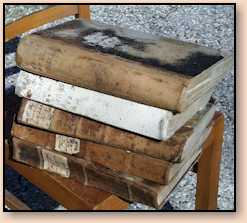|
How did you begin your research?
Did any documents survive the Holocaust and World War II?
Excerpted from Portraits of Our Past: Jews of the German Countryside:
“In 1992 I began to research my family’s history. Among the papers I collected were several pages of a handwritten, German-language Jewish family register. I was told that a relative had copied down the information before he fled Germany
in May 1941. With help I could read “Berlizheimer,” a name I knew, and “Gundelfinger,” a name I had never heard before. I could decipher the name of the village,
“Mühringen,” written at the top of the page. No one had ever mentioned Mühringen to me, nor had any stories about the village or the people been handed down. I only knew that my ancestors had come to America “early” from Germany.
Before my husband and I went on a trip to Germany in 1994, I tossed the pages of the family registers into my suitcase. I had assumed that due to the destruction wrought during the Second World War, I would not be able to find any information about my family. …The archives in these rural villages and towns had survived World War II intact because they had not been the targets of Allied bombing. The documents in the regional and state archives had been moved during the war to safe locations, and most of those documents had survived as well.
|

|
I was able to photocopy official family registers, tax and house information, emigration applications, government documents about the Jewish communities, and documents about my family. I could decipher the old German script just well enough to find surnames in the huge stacks of old registers and documents. Each time I found the signature of one of my ancestors, either in German or in Hebrew, on a fragile yellowed page, I felt that my history was coming alive. I was overwhelmed by the sheer quantity of documents I had been able to collect….”
|
How did you get the documents translated?
“Back in the United States, I just stared at the stacks of documents. My history was in them, but I could not read a word. Luckily, elderly non-Jewish Germans living in my area were able to translate the documents from the difficult-to-read old German script.” I would tape record the session and then type the translation into the computer while following the old German writing. I could then locate more documents during my months in the German archives.
How many documents did you find?
From 1994-1999 during 40 weeks of research, I found over 2,600 documents. They ranged from just a line or two to documents of over 100 handwritten pages. I gradually expanded my research from the family, to the extended family, to the Jewish community in the village or town, to historical and social events in the kingdom.
Where can I obtain more detailed information about researching in the German-speaking archives?
“A Blueprint for Researchers,” included in Portraits of Our Past: Jews of the German Countryside, is a nuts and bolts guide to doing research in the village, town, county, and state archives. Information provided includes: the types of documents, the names of the documents in German, the information the researcher can expect to find, and how the documents are organized.
In addition, the book’s endnotes focus on helping the researcher find information in the state archives.
Please note: I do not translate documents or have access to translators. I would suggest you contact
any German club or association to seek out elderly Germans.
Please note: I do not undertake genealogical research, but I would be glad to answer any general research questions. |